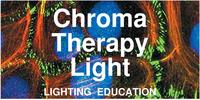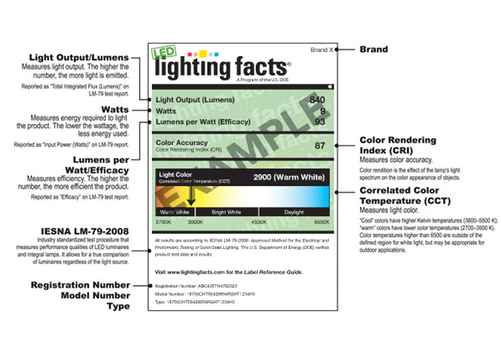LED LPW - Learning Objectives
What does the DOE (Department of Energy) and California Title 24 Energy Code require for efficiency in light sources?Since light sources vary in efficiency, how do you compare them?
What is the difference between efficiency and efficacy?The basic question is how much light is generated from a source per watt? This gets confusing when we need to add current controlling devices such as ballasts and drivers that also consume energy, so the end result is that the number needs to include the total amount of watts needed to create the lumens of light emitted from a complete light fixture. A light fixture, called a 'luminaire' includes the light source, the current controller, and the housing.
EFFICIENCY = LPW or Lumens Per Watt of the complete luminaire. EFFICACY = the light output from the source, before the addition of the fixture, electronic current controllers, housing, and lens. As you can see from the definitions below, this is a confusing metric that appears to go in circles. The IES (Illuminating Engineering Society provides the following definitions:
Efficiency: efficiency[9.4.10] (See luminaire efficiency and radiant efficiency.) radiant efficiency[2.6.2] (of a source of radiation) (ηe) Ratio of the radiant flux of the emitted radiation to the power consumed by the source. Unit: 1.36 Note: It must be specified whether or not the power dissipated by any auxiliary equipment such as ballasts, if any, is included in the power consumed by the source. 36. International Lighting Vocabulary, Third Edition CIE Document 17.4, Vienna: Commission Internationale de l’Eclairage, 1987. luminaire efficiency[9.4.8] NOTE: This term’s definition was changed in RP-16-17 Addendum 1. Deletions have a strike-through. New text is bold. The ratio of luminous flux (lumens) emitted by a luminaire to that emitted by the lamp or lamps used therein. The luminous flux emitted by a luminaire, divided by the luminous flux emitted by the source(s). Sometimes called light output ratio (LOR). Efficacy: efficacy[3.11.1] (See luminous efficacy of a source of light and spectral luminous efficacy of radiant flux.) The luminous flux emitted by a luminaire, divided by the luminous flux emitted by the source(s). Sometimes called light output ratio (LOR). light output ratio:See luminaire efficiency. |
Lighting Facts - Comparing the numbers
DOE - Department of Energy
|
- Home
-
- CHROMA Topics
- Color Spectrum - Light is Energy
- Color in Light
- Color in Nature
- Color in Paint
- Why does paint fade?
- Color Names & Meanings
- Color Phenomena
- Color Perception is Individual
- Color In Fashion
- Color for your home
- Color in Space
- Color Blindness
- Color Blind Interview
- Synesthesia
- Synesthete Deborah Borrowdale-Cox
- Synesthete Stephen Orr, BH&G Editor
-
- Circadian & THERAPY Topics
- Circadian Explained
- Circadian Ganglion Cells
- Circadian Melatonin
- Circadian Animals
- Circadian Research
- Autism & Lighting for the Spectrum
- Blue Light Dimming Apps
- Red Night Lights
- Vitamin D & Light
- SAD - Seasonal Affective Disorder
- Alzheimers and Light Therapy
- Photosensitivity - Light Sensitive Drugs
- Red Light Therapy
- Sleep & Lighting
- Dreams and Second Sleep
- NASA - Lighting in Space & Undersea
- Jet Lag
- Sunglasses
- Chakras
- Crystals, Minerals, & Gemstones
-
- LIGHTing Design Topics
- UV Germicidal Disinfection Light
- LED Lighting Facts Card
- CRI - Color Rendering Index
- LED TM-30
- LED Kelvin Color
- LED LPW
- LED Flicker
- LED Glare
- OLED - Organic LED
- Human Centric Lighting
- Lighting with Daylighting
- Lighting for Healthy Buildings & Zero Net Energy
- Lighting for Healthcare
- Lighting for Horticulture
- Lighting for Hospitality & LED Retrofits
- Lighting for Museums
- Lighting for Seniors & Low Vision
- Lighting Design Tips & Codes
- Parking Lot Lighting
- Solar Lighting for Humanity & World Health
- Davis Insectary Garden
- Santa Barbara Mesa Insectary Garden
- Home
-
- CHROMA Topics
- Color Spectrum - Light is Energy
- Color in Light
- Color in Nature
- Color in Paint
- Why does paint fade?
- Color Names & Meanings
- Color Phenomena
- Color Perception is Individual
- Color In Fashion
- Color for your home
- Color in Space
- Color Blindness
- Color Blind Interview
- Synesthesia
- Synesthete Deborah Borrowdale-Cox
- Synesthete Stephen Orr, BH&G Editor
-
- Circadian & THERAPY Topics
- Circadian Explained
- Circadian Ganglion Cells
- Circadian Melatonin
- Circadian Animals
- Circadian Research
- Autism & Lighting for the Spectrum
- Blue Light Dimming Apps
- Red Night Lights
- Vitamin D & Light
- SAD - Seasonal Affective Disorder
- Alzheimers and Light Therapy
- Photosensitivity - Light Sensitive Drugs
- Red Light Therapy
- Sleep & Lighting
- Dreams and Second Sleep
- NASA - Lighting in Space & Undersea
- Jet Lag
- Sunglasses
- Chakras
- Crystals, Minerals, & Gemstones
-
- LIGHTing Design Topics
- UV Germicidal Disinfection Light
- LED Lighting Facts Card
- CRI - Color Rendering Index
- LED TM-30
- LED Kelvin Color
- LED LPW
- LED Flicker
- LED Glare
- OLED - Organic LED
- Human Centric Lighting
- Lighting with Daylighting
- Lighting for Healthy Buildings & Zero Net Energy
- Lighting for Healthcare
- Lighting for Horticulture
- Lighting for Hospitality & LED Retrofits
- Lighting for Museums
- Lighting for Seniors & Low Vision
- Lighting Design Tips & Codes
- Parking Lot Lighting
- Solar Lighting for Humanity & World Health
- Davis Insectary Garden
- Santa Barbara Mesa Insectary Garden






